Alexandre Sablayrolles
Magistral
Jun 12, 2025Abstract:We introduce Magistral, Mistral's first reasoning model and our own scalable reinforcement learning (RL) pipeline. Instead of relying on existing implementations and RL traces distilled from prior models, we follow a ground up approach, relying solely on our own models and infrastructure. Notably, we demonstrate a stack that enabled us to explore the limits of pure RL training of LLMs, present a simple method to force the reasoning language of the model, and show that RL on text data alone maintains most of the initial checkpoint's capabilities. We find that RL on text maintains or improves multimodal understanding, instruction following and function calling. We present Magistral Medium, trained for reasoning on top of Mistral Medium 3 with RL alone, and we open-source Magistral Small (Apache 2.0) which further includes cold-start data from Magistral Medium.
Pixtral 12B
Oct 09, 2024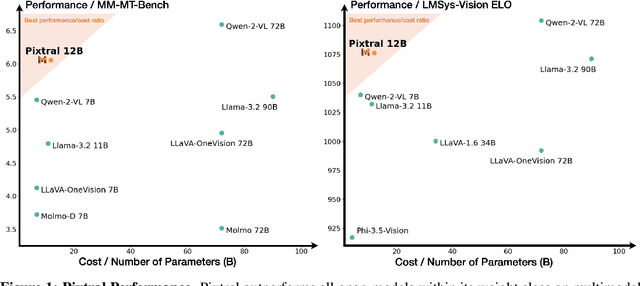
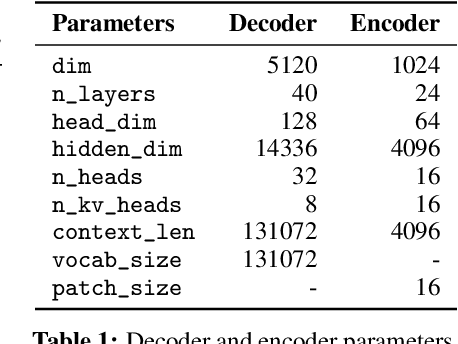
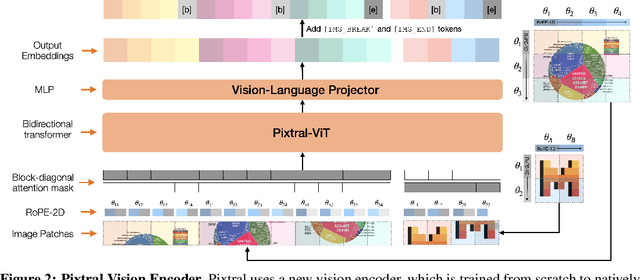
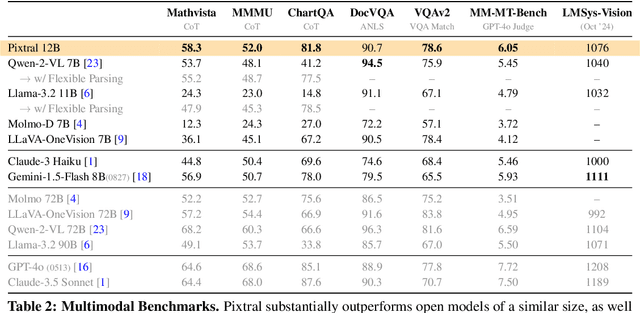
Abstract:We introduce Pixtral-12B, a 12--billion-parameter multimodal language model. Pixtral-12B is trained to understand both natural images and documents, achieving leading performance on various multimodal benchmarks, surpassing a number of larger models. Unlike many open-source models, Pixtral is also a cutting-edge text model for its size, and does not compromise on natural language performance to excel in multimodal tasks. Pixtral uses a new vision encoder trained from scratch, which allows it to ingest images at their natural resolution and aspect ratio. This gives users flexibility on the number of tokens used to process an image. Pixtral is also able to process any number of images in its long context window of 128K tokens. Pixtral 12B substanially outperforms other open models of similar sizes (Llama-3.2 11B \& Qwen-2-VL 7B). It also outperforms much larger open models like Llama-3.2 90B while being 7x smaller. We further contribute an open-source benchmark, MM-MT-Bench, for evaluating vision-language models in practical scenarios, and provide detailed analysis and code for standardized evaluation protocols for multimodal LLMs. Pixtral-12B is released under Apache 2.0 license.
Mixtral of Experts
Jan 08, 2024



Abstract:We introduce Mixtral 8x7B, a Sparse Mixture of Experts (SMoE) language model. Mixtral has the same architecture as Mistral 7B, with the difference that each layer is composed of 8 feedforward blocks (i.e. experts). For every token, at each layer, a router network selects two experts to process the current state and combine their outputs. Even though each token only sees two experts, the selected experts can be different at each timestep. As a result, each token has access to 47B parameters, but only uses 13B active parameters during inference. Mixtral was trained with a context size of 32k tokens and it outperforms or matches Llama 2 70B and GPT-3.5 across all evaluated benchmarks. In particular, Mixtral vastly outperforms Llama 2 70B on mathematics, code generation, and multilingual benchmarks. We also provide a model fine-tuned to follow instructions, Mixtral 8x7B - Instruct, that surpasses GPT-3.5 Turbo, Claude-2.1, Gemini Pro, and Llama 2 70B - chat model on human benchmarks. Both the base and instruct models are released under the Apache 2.0 license.
Mistral 7B
Oct 10, 2023



Abstract:We introduce Mistral 7B v0.1, a 7-billion-parameter language model engineered for superior performance and efficiency. Mistral 7B outperforms Llama 2 13B across all evaluated benchmarks, and Llama 1 34B in reasoning, mathematics, and code generation. Our model leverages grouped-query attention (GQA) for faster inference, coupled with sliding window attention (SWA) to effectively handle sequences of arbitrary length with a reduced inference cost. We also provide a model fine-tuned to follow instructions, Mistral 7B -- Instruct, that surpasses the Llama 2 13B -- Chat model both on human and automated benchmarks. Our models are released under the Apache 2.0 license.
Privately generating tabular data using language models
Jun 07, 2023Abstract:Privately generating synthetic data from a table is an important brick of a privacy-first world. We propose and investigate a simple approach of treating each row in a table as a sentence and training a language model with differential privacy. We show this approach obtains competitive results in modelling tabular data across multiple datasets, even at small scales that favor alternative methods based on marginal distributions.
Analyzing Privacy Leakage in Machine Learning via Multiple Hypothesis Testing: A Lesson From Fano
Oct 24, 2022



Abstract:Differential privacy (DP) is by far the most widely accepted framework for mitigating privacy risks in machine learning. However, exactly how small the privacy parameter $\epsilon$ needs to be to protect against certain privacy risks in practice is still not well-understood. In this work, we study data reconstruction attacks for discrete data and analyze it under the framework of multiple hypothesis testing. We utilize different variants of the celebrated Fano's inequality to derive upper bounds on the inferential power of a data reconstruction adversary when the model is trained differentially privately. Importantly, we show that if the underlying private data takes values from a set of size $M$, then the target privacy parameter $\epsilon$ can be $O(\log M)$ before the adversary gains significant inferential power. Our analysis offers theoretical evidence for the empirical effectiveness of DP against data reconstruction attacks even at relatively large values of $\epsilon$.
TAN without a burn: Scaling Laws of DP-SGD
Oct 07, 2022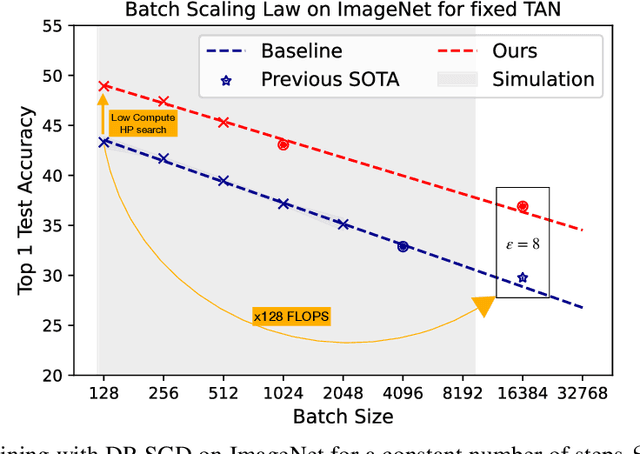



Abstract:Differentially Private methods for training Deep Neural Networks (DNNs) have progressed recently, in particular with the use of massive batches and aggregated data augmentations for a large number of steps. These techniques require much more compute than their non-private counterparts, shifting the traditional privacy-accuracy trade-off to a privacy-accuracy-compute trade-off and making hyper-parameter search virtually impossible for realistic scenarios. In this work, we decouple privacy analysis and experimental behavior of noisy training to explore the trade-off with minimal computational requirements. We first use the tools of R\'enyi Differential Privacy (RDP) to show that the privacy budget, when not overcharged, only depends on the total amount of noise (TAN) injected throughout training. We then derive scaling laws for training models with DP-SGD to optimize hyper-parameters with more than a 100 reduction in computational budget. We apply the proposed method on CIFAR-10 and ImageNet and, in particular, strongly improve the state-of-the-art on ImageNet with a +9 points gain in accuracy for a privacy budget epsilon=8.
CANIFE: Crafting Canaries for Empirical Privacy Measurement in Federated Learning
Oct 06, 2022



Abstract:Federated Learning (FL) is a setting for training machine learning models in distributed environments where the clients do not share their raw data but instead send model updates to a server. However, model updates can be subject to attacks and leak private information. Differential Privacy (DP) is a leading mitigation strategy which involves adding noise to clipped model updates, trading off performance for strong theoretical privacy guarantees. Previous work has shown that the threat model of DP is conservative and that the obtained guarantees may be vacuous or may not directly translate to information leakage in practice. In this paper, we aim to achieve a tighter measurement of the model exposure by considering a realistic threat model. We propose a novel method, CANIFE, that uses canaries - carefully crafted samples by a strong adversary to evaluate the empirical privacy of a training round. We apply this attack to vision models trained on CIFAR-10 and CelebA and to language models trained on Sent140 and Shakespeare. In particular, in realistic FL scenarios, we demonstrate that the empirical epsilon obtained with CANIFE is 2-7x lower than the theoretical bound.
Optimal Membership Inference Bounds for Adaptive Composition of Sampled Gaussian Mechanisms
Apr 12, 2022


Abstract:Given a trained model and a data sample, membership-inference (MI) attacks predict whether the sample was in the model's training set. A common countermeasure against MI attacks is to utilize differential privacy (DP) during model training to mask the presence of individual examples. While this use of DP is a principled approach to limit the efficacy of MI attacks, there is a gap between the bounds provided by DP and the empirical performance of MI attacks. In this paper, we derive bounds for the \textit{advantage} of an adversary mounting a MI attack, and demonstrate tightness for the widely-used Gaussian mechanism. We further show bounds on the \textit{confidence} of MI attacks. Our bounds are much stronger than those obtained by DP analysis. For example, analyzing a setting of DP-SGD with $\epsilon=4$ would obtain an upper bound on the advantage of $\approx0.36$ based on our analyses, while getting bound of $\approx 0.97$ using the analysis of previous work that convert $\epsilon$ to membership inference bounds. Finally, using our analysis, we provide MI metrics for models trained on CIFAR10 dataset. To the best of our knowledge, our analysis provides the state-of-the-art membership inference bounds for the privacy.
Defending against Reconstruction Attacks with Rényi Differential Privacy
Feb 15, 2022

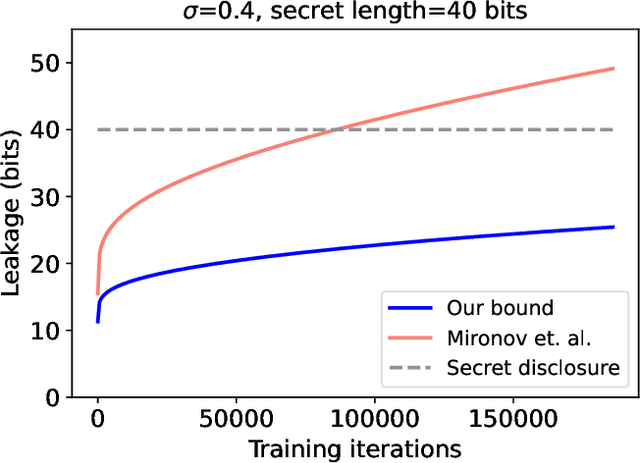
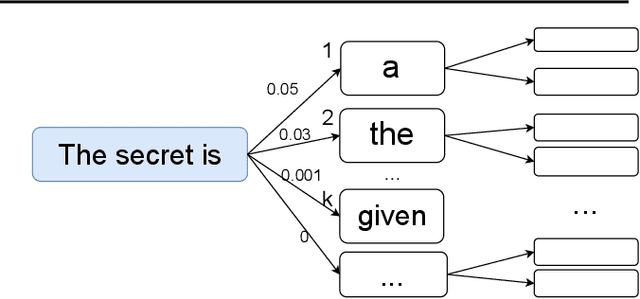
Abstract:Reconstruction attacks allow an adversary to regenerate data samples of the training set using access to only a trained model. It has been recently shown that simple heuristics can reconstruct data samples from language models, making this threat scenario an important aspect of model release. Differential privacy is a known solution to such attacks, but is often used with a relatively large privacy budget (epsilon > 8) which does not translate to meaningful guarantees. In this paper we show that, for a same mechanism, we can derive privacy guarantees for reconstruction attacks that are better than the traditional ones from the literature. In particular, we show that larger privacy budgets do not protect against membership inference, but can still protect extraction of rare secrets. We show experimentally that our guarantees hold against various language models, including GPT-2 finetuned on Wikitext-103.
 Add to Chrome
Add to Chrome Add to Firefox
Add to Firefox Add to Edge
Add to Edge